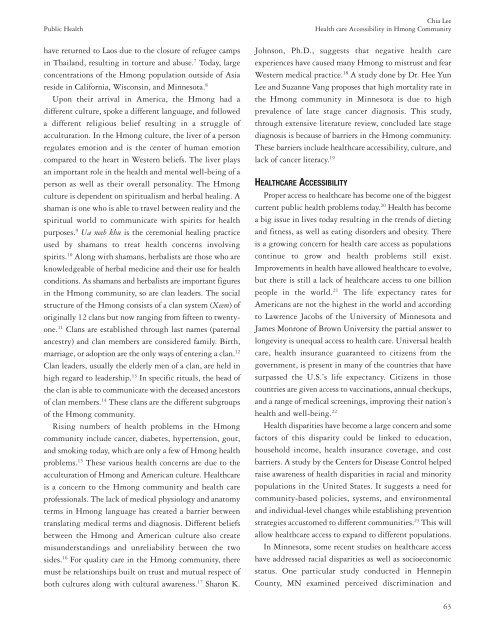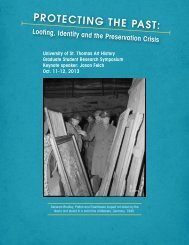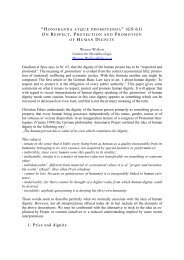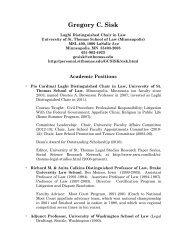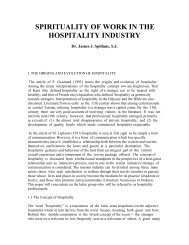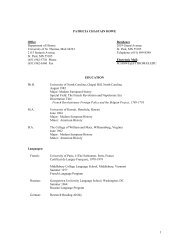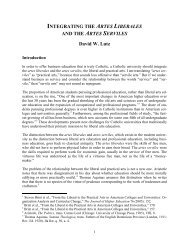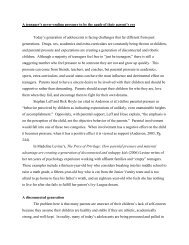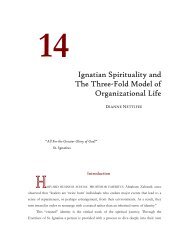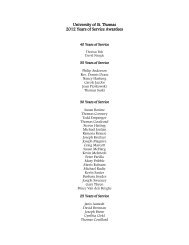dr. ronald e. mcnair acknowledgements - University of St. Thomas
dr. ronald e. mcnair acknowledgements - University of St. Thomas
dr. ronald e. mcnair acknowledgements - University of St. Thomas
Create successful ePaper yourself
Turn your PDF publications into a flip-book with our unique Google optimized e-Paper software.
Chia Lee<br />
Public Health Health care Accessibility in Hmong Community<br />
have returned to Laos due to the closure <strong>of</strong> refugee camps<br />
in Thailand, resulting in torture and abuse. 7 Today, large<br />
concentrations <strong>of</strong> the Hmong population outside <strong>of</strong> Asia<br />
reside in California, Wisconsin, and Minnesota. 8<br />
Upon their arrival in America, the Hmong had a<br />
different culture, spoke a different language, and followed<br />
a different religious belief resulting in a struggle <strong>of</strong><br />
acculturation. In the Hmong culture, the liver <strong>of</strong> a person<br />
regulates emotion and is the center <strong>of</strong> human emotion<br />
compared to the heart in Western beliefs. The liver plays<br />
an important role in the health and mental well-being <strong>of</strong> a<br />
person as well as their overall personality. The Hmong<br />
culture is dependent on spiritualism and herbal healing. A<br />
shaman is one who is able to travel between reality and the<br />
spiritual world to communicate with spirits for health<br />
purposes. 9 Ua neeb khu is the ceremonial healing practice<br />
used by shamans to treat health concerns involving<br />
spirits. 10 Along with shamans, herbalists are those who are<br />
knowledgeable <strong>of</strong> herbal medicine and their use for health<br />
conditions. As shamans and herbalists are important figures<br />
in the Hmong community, so are clan leaders. The social<br />
structure <strong>of</strong> the Hmong consists <strong>of</strong> a clan system (Xeem) <strong>of</strong><br />
originally 12 clans but now ranging from fifteen to twentyone.<br />
11 Clans are established through last names (paternal<br />
ancestry) and clan members are considered family. Birth,<br />
marriage, or adoption are the only ways <strong>of</strong> entering a clan. 12<br />
Clan leaders, usually the elderly men <strong>of</strong> a clan, are held in<br />
high regard to leadership. 13 In specific rituals, the head <strong>of</strong><br />
the clan is able to communicate with the deceased ancestors<br />
<strong>of</strong> clan members. 14 These clans are the different subgroups<br />
<strong>of</strong> the Hmong community.<br />
Rising numbers <strong>of</strong> health problems in the Hmong<br />
community include cancer, diabetes, hypertension, gout,<br />
and smoking today, which are only a few <strong>of</strong> Hmong health<br />
problems. 15 These various health concerns are due to the<br />
acculturation <strong>of</strong> Hmong and American culture. Healthcare<br />
is a concern to the Hmong community and health care<br />
pr<strong>of</strong>essionals. The lack <strong>of</strong> medical physiology and anatomy<br />
terms in Hmong language has created a barrier between<br />
translating medical terms and diagnosis. Different beliefs<br />
between the Hmong and American culture also create<br />
misunderstandings and unreliability between the two<br />
sides. 16 For quality care in the Hmong community, there<br />
must be relationships built on trust and mutual respect <strong>of</strong><br />
both cultures along with cultural awareness. 17 Sharon K.<br />
Johnson, Ph.D., suggests that negative health care<br />
experiences have caused many Hmong to mistrust and fear<br />
Western medical practice. 18 A study done by Dr. Hee Yun<br />
Lee and Suzanne Vang proposes that high mortality rate in<br />
the Hmong community in Minnesota is due to high<br />
prevalence <strong>of</strong> late stage cancer diagnosis. This study,<br />
through extensive literature review, concluded late stage<br />
diagnosis is because <strong>of</strong> barriers in the Hmong community.<br />
These barriers include healthcare accessibility, culture, and<br />
lack <strong>of</strong> cancer literacy. 19<br />
HEALTHCARE ACCESSIBILITY<br />
Proper access to healthcare has become one <strong>of</strong> the biggest<br />
current public health problems today. 20 Health has become<br />
a big issue in lives today resulting in the trends <strong>of</strong> dieting<br />
and fitness, as well as eating disorders and obesity. There<br />
is a growing concern for health care access as populations<br />
continue to grow and health problems still exist.<br />
Improvements in health have allowed healthcare to evolve,<br />
but there is still a lack <strong>of</strong> healthcare access to one billion<br />
people in the world. 21 The life expectancy rates for<br />
Americans are not the highest in the world and according<br />
to Lawrence Jacobs <strong>of</strong> the <strong>University</strong> <strong>of</strong> Minnesota and<br />
James Monrone <strong>of</strong> Brown <strong>University</strong> the partial answer to<br />
longevity is unequal access to health care. Universal health<br />
care, health insurance guaranteed to citizens from the<br />
government, is present in many <strong>of</strong> the countries that have<br />
surpassed the U.S.’s life expectancy. Citizens in those<br />
countries are given access to vaccinations, annual checkups,<br />
and a range <strong>of</strong> medical screenings, improving their nation’s<br />
health and well-being. 22<br />
Health disparities have become a large concern and some<br />
factors <strong>of</strong> this disparity could be linked to education,<br />
household income, health insurance coverage, and cost<br />
barriers. A study by the Centers for Disease Control helped<br />
raise awareness <strong>of</strong> health disparities in racial and minority<br />
populations in the United <strong>St</strong>ates. It suggests a need for<br />
community-based policies, systems, and environmental<br />
and individual-level changes while establishing prevention<br />
strategies accustomed to different communities. 23 This will<br />
allow healthcare access to expand to different populations.<br />
In Minnesota, some recent studies on healthcare access<br />
have ad<strong>dr</strong>essed racial disparities as well as socioeconomic<br />
status. One particular study conducted in Hennepin<br />
County, MN examined perceived discrimination and<br />
63


